читайте также
 Italy May End Tax Relief on Rental Income: What It Means for Landlords and Investors
Italy May End Tax Relief on Rental Income: What It Means for Landlords and Investors
 Luxury Travel Takes Off: How Demand Is Changing and Where to Find ‘Quiet Luxury’
Luxury Travel Takes Off: How Demand Is Changing and Where to Find ‘Quiet Luxury’
 Airbnb shifts all fees to property owners
Airbnb shifts all fees to property owners
 Most Punctual Airlines of September 2025: Who Arrived on Time and Why It Matters
Most Punctual Airlines of September 2025: Who Arrived on Time and Why It Matters
 Ten Years to a Passport: New Citizenship Rules in Portugal
Ten Years to a Passport: New Citizenship Rules in Portugal
 Top 25 World Economies 2025: Who Shapes Global Growth
Top 25 World Economies 2025: Who Shapes Global Growth
The Largest and Smallest Countries in the World: Britannica Ranking
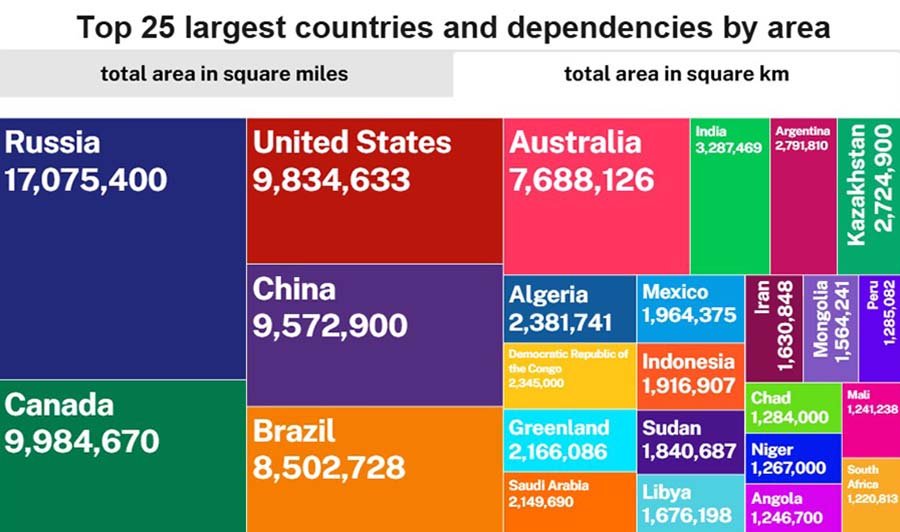
Russia covers more than 17 million sq. km, while the Vatican takes up less than one. This gap is reflected in Britannica’s data on the areas of countries and dependent territories. The contrast between giants and microstates shows just how uneven the world map is. The picture becomes even more striking when comparing land size with population.
Topping the ranking is Russia, with a territory of over 17 million sq. km and a population close to 146 million. Despite its vast size, its population density remains among the lowest worldwide. Canada comes second with 10 million sq. km but only around 40 million inhabitants, highlighting the enormous gap between landmass and demographics. China, covering 9.6 million sq. km, remains the most populous nation, home to more than 1.4 billion people. The U.S. has a similar land area of about 9.5 million sq. km with a population of roughly 340 million. Brazil rounds out the top five: 8.5 million sq. km and 214 million people.
In sixth place is Australia with 7.6 million sq. km but only about 26 million inhabitants. It is one of the clearest examples of imbalance between territory and population: the country occupies almost an entire continent yet remains sparsely populated. India, with just 3.2 million sq. km, has more than 1.4 billion people, making it a demographic giant. Argentina maintains a relatively low density with 2.7 million sq. km and 46 million people. Kazakhstan has nearly the same land size but fewer than 19 million residents. Algeria, the largest state in Africa, ranks tenth with 2.3 million sq. km and around 44 million inhabitants.
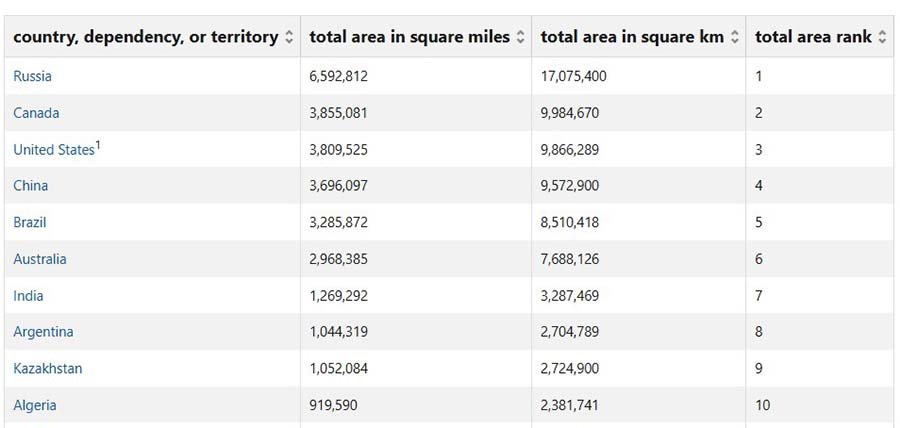
The Democratic Republic of the Congo is vast as well, with 2.3 million sq. km and more than 100 million people. Saudi Arabia spans 2.15 million sq. km with a population of about 36 million. Mexico covers nearly 2 million sq. km and is home to around 130 million. Indonesia extends across 1.9 million sq. km, making it the largest country in Southeast Asia by territory, while hosting a population exceeding 280 million.
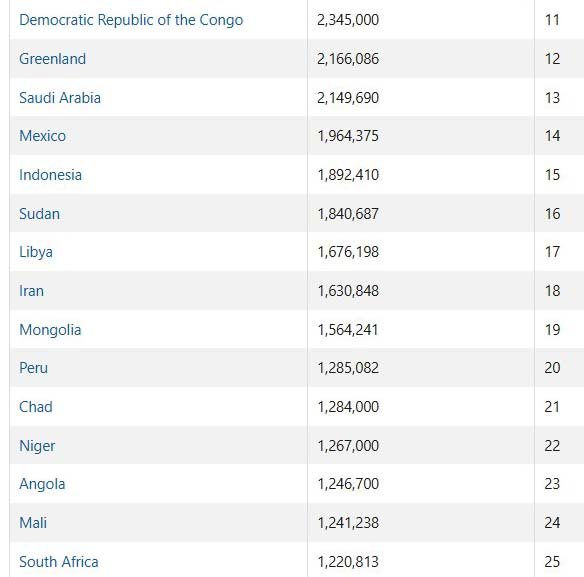
Libya covers 1.76 million sq. km but has only 7 million residents. Iran measures 1.65 million sq. km with a population of about 89 million. Mongolia is a prime example of low density: 1.56 million sq. km and just 3.5 million inhabitants. Completing the list of countries over 1 million sq. km are Peru (1.28 million sq. km, about 34 million) and Colombia (1.14 million sq. km, nearly 53 million).
Egypt has a landmass of about 1 million sq. km and more than 110 million inhabitants. Turkey covers 783,000 sq. km with a population of around 86 million. Afghanistan (652,000 sq. km, 42 million) and Ukraine (603,000 sq. km, 37 million) are close in both size and population.
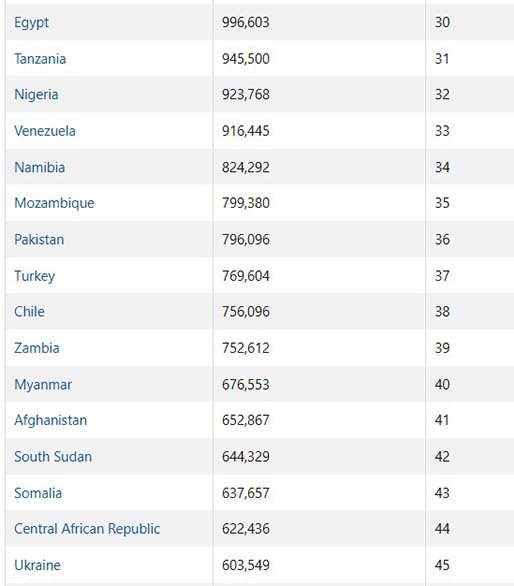
Other countries include:
France – 551,000 sq. km, about 65 million;
Thailand – 513,000 sq. km, 70 million;
Spain – 505,000 sq. km, 47 million.
Norway spans 385,000 sq. km but has only 5.5 million inhabitants. Japan is slightly smaller at 378,000 sq. km, but with nearly 123 million residents, it is among the most densely populated countries. Germany has 357,000 sq. km and more than 84 million people. Finland covers 338,000 sq. km with about 5.6 million residents.
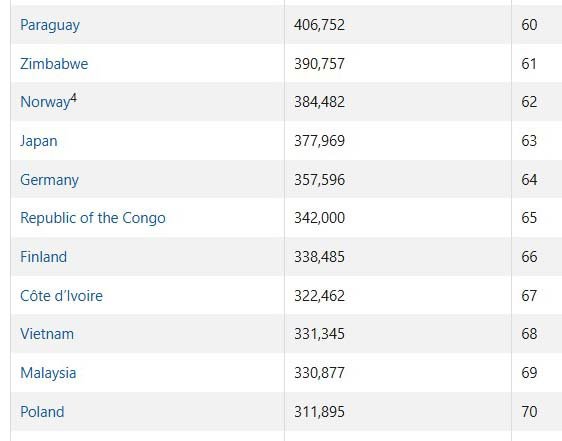
The contrast between area and population is clear in Vietnam and Poland: 331,000 and 313,000 sq. km respectively, but with more than 100 million and about 40 million residents. New Zealand’s figures are even more striking: 268,000 sq. km and fewer than 5 million people. The United Kingdom has 244,000 sq. km with around 68 million inhabitants. Belarus spans 207,000 sq. km with a population of about 9.5 million.
Bulgaria’s 6.3 million people live on 111,000 sq. km, while South Korea’s 51 million are packed into just 100,000 sq. km. Hungary and Portugal are comparable at 93,000 and 92,000 sq. km, with 9.5 and 10 million people respectively, as are the Czech Republic and Serbia – 79,000 and 77,000 sq. km, with 10.5 and 6.6 million residents.
The United Arab Emirates has 84,000 sq. km and about 9.5 million inhabitants. Ireland spans 70,000 sq. km with around 5.2 million people. Georgia covers 69,000 sq. km with a population of about 3.7 million. In the Baltics, Lithuania leads with 65,000 sq. km and 2.8 million residents, followed by Latvia (64,000 sq. km, 1.8 million) and Estonia (45,000 sq. km, 1.3 million).
Among Europe’s small states, Luxembourg is the largest with 2,600 sq. km and more than 600,000 residents. Andorra has 468 sq. km and about 80,000 people. Malta, in the Mediterranean, covers 316 sq. km with around half a million inhabitants. Liechtenstein is even smaller at 160 sq. km and about 40,000 people. San Marino counts 61 sq. km and 34,000. In Oceania, Tuvalu (26 sq. km, 11,000) and Nauru (21 sq. km, about 12,000) stand out. Monaco occupies just 2 sq. km and has around 40,000 residents. The smallest state in the ranking remains the Vatican – less than 1 sq. km and about 800 people.
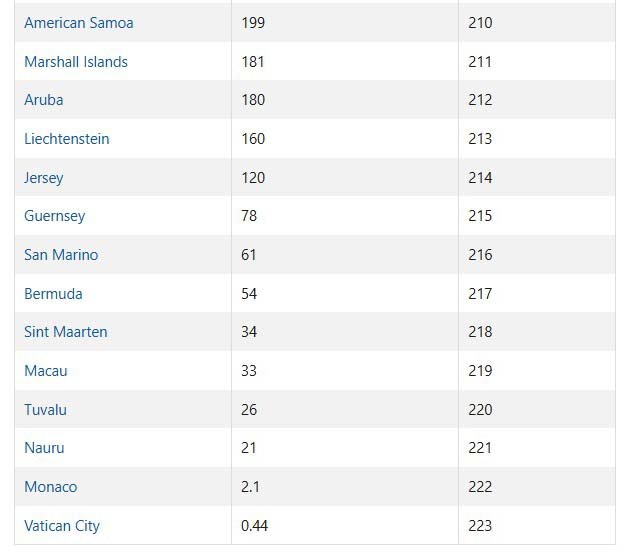
Comparing land size and population reveals how uneven the global map is. The largest countries by territory are not always demographic centers, while small nations can concentrate tens and even hundreds of millions of people. This contrast vividly underscores differences in resource distribution, density, and the role of countries in the global system.





